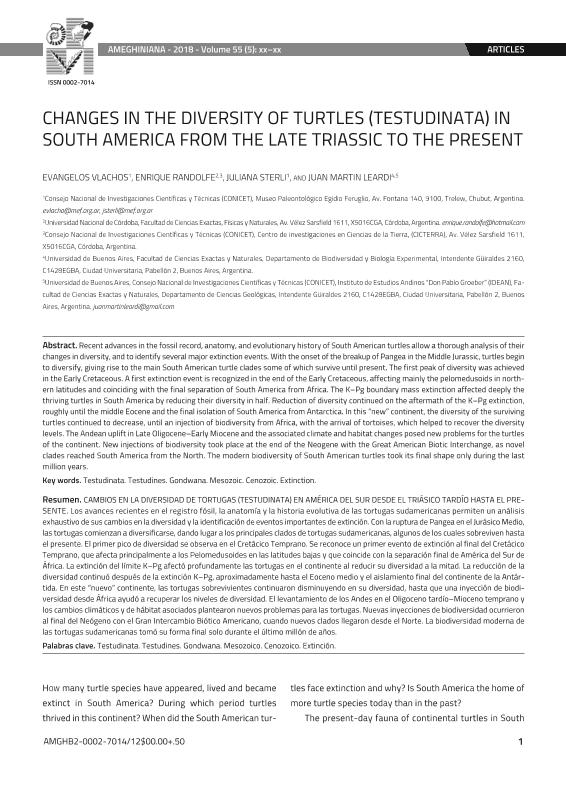Mostrar el registro sencillo del ítem
dc.contributor.author
Vlachos, Evangelos

dc.contributor.author
Randolfe, Enrique Alberto

dc.contributor.author
Sterli, Juliana

dc.contributor.author
Leardi, Juan Martín

dc.date.available
2019-10-10T18:28:09Z
dc.date.issued
2018-12
dc.identifier.citation
Vlachos, Evangelos; Randolfe, Enrique Alberto; Sterli, Juliana; Leardi, Juan Martín; Changes in the Diversity of Turtles (Testudinata) in South America from the Late Triassic to the Present; Asociación Paleontológica Argentina; Ameghiniana; 55; 6; 12-2018; 619-643
dc.identifier.issn
1851-8044
dc.identifier.uri
http://hdl.handle.net/11336/85561
dc.description.abstract
Los avances recientes en el registro fósil, la anatomía y la historia evolutiva de las tortugas sudamericanas permiten un análisis exhaustivo de sus cambios en la diversidad y la identificación de eventos importantes de extinción. Con la ruptura de Pangea en el Jurásico Medio, las tortugas comienzan a diversificarse, dando lugar a los principales clados de tortugas sudamericanas, algunos de los cuales sobreviven hasta el presente. El primer pico de diversidad se observa en el Cretácico Temprano. Se reconoce un primer evento de extinción al final del Cretácico Temprano, que afecta principalmente a los Pelomedusoides en las latitudes bajas y que coincide con la separación final de América del Sur de África. La extinción del límite K–Pg afectó profundamente las tortugas en el continente al reducir su diversidad a la mitad. La reducción de la diversidad continuó después de la extinción K–Pg, aproximadamente hasta el Eoceno medio y el aislamiento final del continente de la Antártida. En este “nuevo” continente, las tortugas sobrevivientes continuaron disminuyendo en su diversidad, hasta que una inyección de biodiversidad desde África ayudó a recuperar los niveles de diversidad. El levantamiento de los Andes en el Oligoceno tardío–Mioceno temprano y los cambios climáticos y de hábitat asociados plantearon nuevos problemas para las tortugas. Nuevas inyecciones de biodiversidad ocurrieron al final del Neógeno con el Gran Intercambio Biótico Americano, cuando nuevos clados llegaron desde el Norte. La biodiversidad moderna de las tortugas sudamericanas tomó su forma final solo durante el último millón de años.
dc.description.abstract
Recent advances in the fossil record, anatomy, and evolutionary history of South American turtles allow a thorough analysis of their changes in diversity, and to identify several major extinction events. With the onset of the breakup of Pangea in the Middle Jurassic, turtles begin to diversify, giving rise to the main South American turtle clades some of which survive until present. The first peak of diversity was achieved in the Early Cretaceous. A first extinction event is recognized in the end of the Early Cretaceous, affecting mainly the pelomedusoids in northern latitudes and coinciding with the final separation of South America from Africa. The K–Pg boundary mass extinction affected deeply the thriving turtles in South America by reducing their diversity in half. Reduction of diversity continued on the aftermath of the K–Pg extinction, roughly until the middle Eocene and the final isolation of South America from Antarctica. In this “new” continent, the diversity of the surviving turtles continued to decrease, until an injection of biodiversity from Africa, with the arrival of tortoises, which helped to recover the diversity levels. The Andean uplift in Late Oligocene–Early Miocene and the associated climate and habitat changes posed new problems for the turtles of the continent. New injections of biodiversity took place at the end of the Neogene with the Great American Biotic Interchange, as novel clades reached South America from the North. The modern biodiversity of South American turtles took its final shape only during the last million years.
dc.format
application/pdf
dc.language.iso
eng
dc.publisher
Asociación Paleontológica Argentina

dc.rights
info:eu-repo/semantics/openAccess
dc.rights.uri
https://creativecommons.org/licenses/by-nc-sa/2.5/ar/
dc.subject
CENOZOIC
dc.subject
EXTINCTION
dc.subject
GONDWANA
dc.subject
MESOZOIC
dc.subject
TESTUDINATA
dc.subject
TESTUDINES
dc.subject.classification
Paleontología

dc.subject.classification
Ciencias de la Tierra y relacionadas con el Medio Ambiente

dc.subject.classification
CIENCIAS NATURALES Y EXACTAS

dc.title
Changes in the Diversity of Turtles (Testudinata) in South America from the Late Triassic to the Present
dc.title
Cambios en la diversidad de tortugas (Testudinata) en América del Sur desde el triásico tardío hasta el presente
dc.type
info:eu-repo/semantics/article
dc.type
info:ar-repo/semantics/artículo
dc.type
info:eu-repo/semantics/publishedVersion
dc.date.updated
2019-10-10T13:46:01Z
dc.identifier.eissn
1851-8044
dc.journal.volume
55
dc.journal.number
6
dc.journal.pagination
619-643
dc.journal.pais
Argentina

dc.description.fil
Fil: Vlachos, Evangelos. Museo Paleontológico Egidio Feruglio; Argentina. Consejo Nacional de Investigaciones Científicas y Técnicas; Argentina
dc.description.fil
Fil: Randolfe, Enrique Alberto. Consejo Nacional de Investigaciones Científicas y Técnicas; Argentina. Universidad Nacional de Córdoba. Facultad de Ciencias Exactas, Físicas y Naturales; Argentina
dc.description.fil
Fil: Sterli, Juliana. Consejo Nacional de Investigaciones Científicas y Técnicas; Argentina. Museo Paleontológico Egidio Feruglio; Argentina
dc.description.fil
Fil: Leardi, Juan Martín. Consejo Nacional de Investigaciones Científicas y Técnicas; Argentina. Universidad de Buenos Aires. Facultad de Ciencias Exactas y Naturales; Argentina
dc.journal.title
Ameghiniana

dc.relation.alternativeid
info:eu-repo/semantics/altIdentifier/url/http://www.ameghiniana.org.ar/index.php/ameghiniana/article/view/3226
dc.relation.alternativeid
info:eu-repo/semantics/altIdentifier/doi/http://dx.doi.org/10.5710/AMGH.18.09.2018.3226
dc.relation.alternativeid
info:eu-repo/semantics/altIdentifier/url/http://www.ameghiniana.org.ar/index.php/ameghiniana/article/view/3226
Archivos asociados
